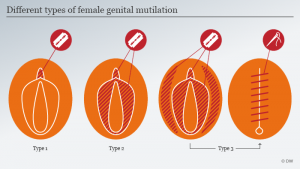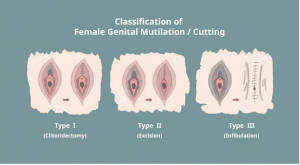
Table of Contents
What is Female Genital Mutilation (FGM)?
- Female Genital Mutilation (FGM) is an intentional activity to alter or cause injury to the female genital organs for non-medical reasons.
- Simply, it is an act of removing the exterior part of female genital.
- Female genital mutilation (FGM) encompasses the activity that comprise of fractional or complete removal of the exterior part of female genitalia, or other harm to the female genital organs for non-medical motives.
- In some places, it is also referred as female circumcision.
- The practice (FGM) does not have any health benefits for female
- Traditional circumcisers, who often play other chief parts in societies, such as joining childbirths, frequently carry out the practice.
- In many settings, health care providers perform FGM due to the erroneous belief that the procedure is safer when medicalized.
Global Facts about Female Genital Mutilation (FGM):
- Female genital mutilation (FGM) contains procedures that purposely change or cause harm to the female genital organs for non-medical causes.
- Procedures can cause severe bleeding and complications urinating, and well ahead cysts, infections, along with obstacles in childbirth and increased threat of newborn deaths.
- Over 200 million girls and women thriving today have been cut in 30 nations in Africa, the Middle East and Asia where FGM is focused (UNICEF, New York, 2016)
- With 140 million African women have suffered FGM and 3 million girls in Africa being at threat yearly of FGM, the practice remains a concern for several.
- FGM does not just occur in Africa. It occurs in some countries of the Middle East, Asia and migrants from these areas.
- FGM is commonly carried out on young girls concerning infancy and age 15.
- FGM is an abuse of the human rights of girls and women.
Different Types/Procedures of FGM:
Female genital mutilation is mainly categorized into four major types:
- Type 1 (Clitoridectomy): It is the limited or total elimination of the clitoris and in very rare circumstances, merely the prepuce (the fold of skin surrounding the clitoris).
- Type 2 (Excision): This is the partial or total removal of the clitoris and the labia minora with or devoid of excision of the labia majora.
- Type 3 (Infibulation): This is the tapering of the vaginal opening through the formation of a covering seal. The seal is formed by cutting and relocating the labia minora, or labia majora, at times through stitching, with or without deletion of the clitoris (clitoridectomy).
- Type 4: This includes all other detrimental procedures to the female genitalia for non-medical determinations, e.g. perforating, penetrating, slitting, scratching and sealing the genital area.


Type I and II is most common in different countries and societies.
Deinfibulation refers to the practice of cutting open the sealed vaginal opening in a woman who has been infibulated, which is often obligatory for refining health and welfare along with to let intercourse or to simplify childbirth.
Reasons For Practicing FGM:
-
Cultural, religious and social factors among families and communities:
- FGM is a social contract. It is a social burden and social pressure to confirm that an individual is following what the society/community is practicing. It is a tough motivation to last the practice.
- FGM is often considered obligatory part of raising a girl correctly and preparing her for matrimonial/adulthood.
- FGM is often enthused by principles about what is deliberated proper sexual behavior.
- FGM is connected with the cultural ethics of feminineness and restraint in some communities
- The most prevalent explanations for FGM is that it lessens a woman’s sex drive.
- Some practitioners and followers of FGM often consider the practice has sacred maintenance. Some religious leaders take erratic spots concerning FGM: some encourage it, some consider it inappropriate and others contributors to its abolition.
- Local assemblies of supremacy and ability can continue the preservation of practice.
- In some cultures, recent acceptance of FGM is related to lifting the traditions of close groups, or part of a broader religious or traditional revival effort.
- In some societies, new groups practice FGM when they travel into areas where the local population practice FGM.
Health Effects and Medical Complications of FGM:
Immediate Complications of FGM:
- Severe bleeding
- Persistent pain
- Genital tissue swelling
- Recurrent infections, which can lead to infertility
- Complications during urination
- Injury to surrounding genital tissue
- Shock: Several girls die from blood loss or septicity as a straight result of the procedure.
- Death
Long Term Complications of FGM:
- Urinary problems
- Vaginal problems (discharge, itching and other infections)
- Painful menstruation (difficulty in passing menstrual blood)
- Pain and struggle during intimacy
- Hemorrhage, cysts, and blisters
- Mental health problems like depression, hallucinations, low self-esteem and acts of self-harm
- Problems in the course of labor and delivery, which can be life-threatening for mother and baby
More Specifically, Problems Related to FGM are:
- FGM and sex
- FGM can make it challenging and hurting to have sex. It can also result in reduced sexual desire and a lack of agreeable sensation.
- FGM and pregnancy
- Some women with FGM may find it challenging to become pregnant, and those who do consider can have complications in childbirth.
- FGM and mental health
- FGM can be a tremendously traumatic experience that can cause emotional troubles through life, including:
- Misery
- Anxiety
- Flashbacks to the time of the cutting
- Bad dream and other sleep problems
- In some cases, women may not reminisce having the FGM at all, particularly if it was performed when they were an infant.
- FGM can be a tremendously traumatic experience that can cause emotional troubles through life, including:
Efforts to Eliminate FGM:
In 2008, the World Health Assembly passed resolution WHA61.16 on the elimination of FGM, emphasizing different sectors (health, education, finance, justice and women’s affairs) to take necessary actions to eliminate FGM.
WHO efforts to eliminate female genital mutilation focus on (WHO, 2019):
|
References and For More Information:
https://www.who.int/news-room/fact-sheets/detail/female-genital-mutilation
https://www.theguardian.com/society/video/2016/feb/05/facts-you-should-know-about-fgm-video
https://www.unfpa.org/news/top-5-things-you-didnt-know-about-female-genital-mutilation
https://theconversation.com/why-the-law-against-female-genital-mutilation-should-be-scrapped-79851
https://www.change.org/p/united-nations-strict-action-female-genital-mutilation
https://www.healthline.com/health-news/surgery-for-victims-of-female-genital-mutilation-fb#1
https://www.nhs.uk/conditions/female-genital-mutilation-fgm/
https://www.medicalnewstoday.com/articles/241726.php